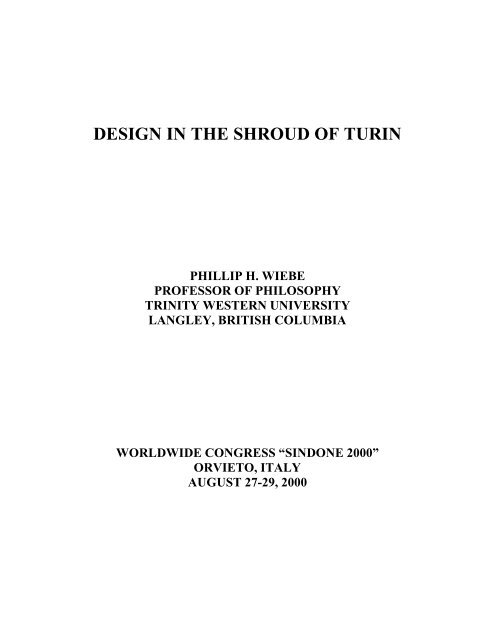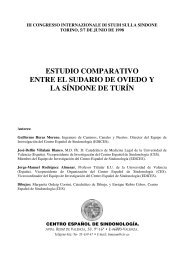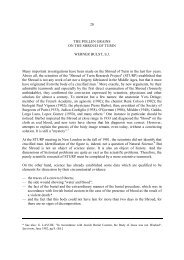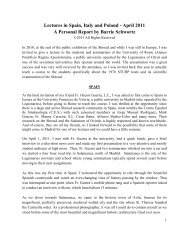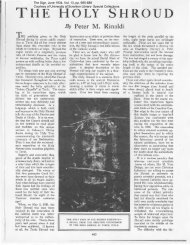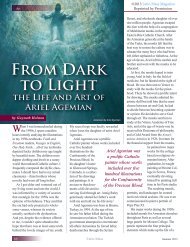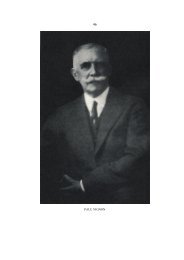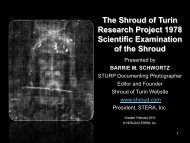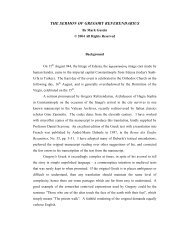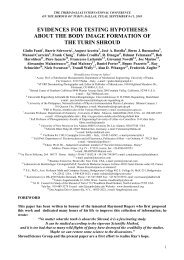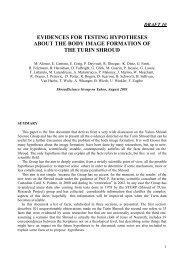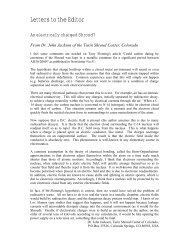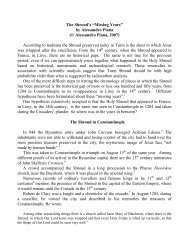Design in the Shroud of Turin - The Shroud of Turin Website
Design in the Shroud of Turin - The Shroud of Turin Website
Design in the Shroud of Turin - The Shroud of Turin Website
Create successful ePaper yourself
Turn your PDF publications into a flip-book with our unique Google optimized e-Paper software.
DESIGN IN THE SHROUD OF TURINPHILLIP H. WIEBEPROFESSOR OF PHILOSOPHYTRINITY WESTERN UNIVERSITYLANGLEY, BRITISH COLUMBIAWORLDWIDE CONGRESS “SINDONE 2000”ORVIETO, ITALYAUGUST 27-29, 2000
2DESIGN IN THE SHROUD OF TURINIntroductionControversy cont<strong>in</strong>ues to surround <strong>the</strong> <strong>Shroud</strong> <strong>of</strong> Tur<strong>in</strong>. <strong>The</strong> carbon dat<strong>in</strong>gtests conducted <strong>in</strong> 1988 that yielded a medieval date conv<strong>in</strong>ced many that it wasnot <strong>the</strong> burial cloth <strong>of</strong> Jesus Christ. However, <strong>the</strong> <strong>in</strong>formation that cont<strong>in</strong>ues to begleaned from <strong>the</strong> <strong>Shroud</strong> suggests o<strong>the</strong>rwise. A recent <strong>the</strong>ory that expla<strong>in</strong>s many<strong>of</strong> <strong>the</strong> <strong>Shroud</strong>’s perplex<strong>in</strong>g properties presents <strong>in</strong>formation that allows anargument from design to be developed, which is rem<strong>in</strong>iscent <strong>of</strong> o<strong>the</strong>r designarguments <strong>in</strong> natural <strong>the</strong>ology. This argument is new to natural <strong>the</strong>ology, to myknowledge, and really requires giv<strong>in</strong>g more attention to <strong>the</strong> <strong>Shroud</strong> than I canprovide <strong>in</strong> a short paper, but I will sketch <strong>the</strong> necessary <strong>in</strong>formation about <strong>the</strong><strong>Shroud</strong> needed to advance it.<strong>The</strong> <strong>the</strong>ory I will exam<strong>in</strong>e is <strong>of</strong> particular <strong>in</strong>terest if <strong>the</strong> <strong>Shroud</strong> is not an artobject. <strong>The</strong> evidence suggest<strong>in</strong>g that it is not is impressive, and has been advancedby o<strong>the</strong>rs. I will not review this evidence here, however. 1 <strong>The</strong> <strong>the</strong>ory embedd<strong>in</strong>g<strong>the</strong> design argument that I will advance claims that <strong>the</strong> <strong>Shroud</strong> f<strong>in</strong>ds its orig<strong>in</strong>s <strong>in</strong>some process associated with <strong>the</strong> body <strong>of</strong> a Man, apparently killed by crucifixion,that once lay <strong>in</strong> it. This <strong>the</strong>ory does not assume that <strong>the</strong> Man was Jesus.1 I have outl<strong>in</strong>ed some <strong>of</strong> <strong>the</strong> most impressive reasons <strong>in</strong> an Appendix.
3<strong>The</strong> <strong>The</strong>ory <strong>of</strong> “Weak Dematerialization”Physicist John Jackson, long associated with research <strong>in</strong>to <strong>the</strong> <strong>Shroud</strong>, hasconjectured that <strong>the</strong> body <strong>of</strong> <strong>the</strong> Man <strong>in</strong> <strong>the</strong> <strong>Shroud</strong> “became mechanically“transparent” to its physical surround<strong>in</strong>gs,” and that “a stimulus was generatedthat recorded <strong>the</strong> passage <strong>of</strong> <strong>the</strong> cloth through <strong>the</strong> body region onto <strong>the</strong> cloth as animage.” 2 This stimulus, described as “radiation emitted at all po<strong>in</strong>ts with<strong>in</strong> thatbody” <strong>in</strong>teracted physically with <strong>the</strong> cloth to produce <strong>the</strong> discolorations that form<strong>the</strong> ma<strong>in</strong> Image. This radiation left its impr<strong>in</strong>t on <strong>the</strong> cloth to form <strong>the</strong> frontal anddorsal Images. Jackson notes that <strong>the</strong> somewhat flatter dorsal Image does notquite exhibit <strong>the</strong> “blended, cont<strong>in</strong>uous shad<strong>in</strong>g structure that … conta<strong>in</strong>s acorrelation with presumed cloth-body distance” <strong>of</strong> <strong>the</strong> frontal Image. 3 This feature<strong>of</strong> <strong>the</strong> frontal Image, he says, resulted from that half <strong>of</strong> <strong>the</strong> <strong>Shroud</strong> that covered<strong>the</strong> body fall<strong>in</strong>g through <strong>the</strong> residue <strong>of</strong> <strong>the</strong> Body to add to <strong>the</strong> frontal Image.Jackson postulates two processes for <strong>the</strong> formation <strong>of</strong> <strong>the</strong> frontal Image, and onefor <strong>the</strong> dorsal Image. He acknowledges that this conjecture lies outside normalscience.Physicist and historian <strong>of</strong> science, Thaddeus Trenn, describes <strong>the</strong> essentialelement <strong>in</strong> Jackson’s somewhat obscure account as “weak dematerialization,” and2 John P. Jackson, “An Unconventional Hypo<strong>the</strong>sis to Expla<strong>in</strong> all Image Characteristics Found on<strong>the</strong> <strong>Shroud</strong> Image,” p. 328.3 Ibid., p. 331.
4hypo<strong>the</strong>sizes that <strong>the</strong> nuclei <strong>of</strong> <strong>the</strong> atoms constitut<strong>in</strong>g <strong>the</strong> body <strong>of</strong> <strong>the</strong> Man onceenfolded by <strong>the</strong> <strong>Shroud</strong> broke apart by <strong>the</strong> action <strong>of</strong> some unknown force thatwas capable <strong>of</strong> overcom<strong>in</strong>g <strong>the</strong> strongest force known <strong>in</strong> nature, viz., <strong>the</strong> strongnuclear force. 4 <strong>The</strong> freed subatomic particles left <strong>the</strong>ir “impr<strong>in</strong>t” on <strong>the</strong> cloth, sothat <strong>the</strong> color variations that form <strong>the</strong> Image resulted from <strong>the</strong> number <strong>of</strong>subatomic particles that impacted <strong>the</strong> cloth: <strong>the</strong> fewer <strong>the</strong> number <strong>of</strong> particles, <strong>the</strong>lighter <strong>the</strong> Image (on <strong>the</strong> orig<strong>in</strong>al cloth), and <strong>the</strong> larger <strong>the</strong> number <strong>of</strong> particles, <strong>the</strong>darker <strong>the</strong> Image. Jackson’s <strong>the</strong>ory, as developed by Trenn, conjectures that <strong>the</strong>strong nuclear force with<strong>in</strong> <strong>the</strong> atoms compris<strong>in</strong>g <strong>the</strong> body <strong>of</strong> <strong>the</strong> Man wassimultaneously turned <strong>of</strong>f, and that electromagnetism and gravity were left <strong>in</strong>tact. 5Jackson and Trenn claim that this <strong>the</strong>ory can expla<strong>in</strong> several importantfeatures <strong>of</strong> <strong>the</strong> Image not o<strong>the</strong>rwise expla<strong>in</strong>ed, viz., <strong>the</strong> three-dimensionalcharacter <strong>of</strong> <strong>the</strong> Image and its pixel-like, po<strong>in</strong>tillistic features; <strong>the</strong> fact that <strong>the</strong>Image does not appear to penetrate through <strong>the</strong> cloth but is only on one <strong>of</strong> itssurfaces; <strong>the</strong> absence <strong>of</strong> side images <strong>of</strong> <strong>the</strong> Man; <strong>the</strong> chemical nature <strong>of</strong> <strong>the</strong> Image;<strong>the</strong> differences <strong>in</strong> <strong>the</strong> locations <strong>of</strong> some <strong>of</strong> <strong>the</strong> blood residues (e.g., on <strong>the</strong> hair)and <strong>the</strong> correlated areas <strong>of</strong> <strong>the</strong> Body from which <strong>the</strong> blood appears to haveorig<strong>in</strong>ated; <strong>the</strong> presence <strong>of</strong> blood-impregnated fibers that exhibit no evidence <strong>of</strong>fray<strong>in</strong>g; <strong>the</strong> vertical alignment <strong>of</strong> <strong>the</strong> Image and associated body parts such as <strong>the</strong>4 “<strong>The</strong> <strong>Shroud</strong> <strong>of</strong> Tur<strong>in</strong>: Resett<strong>in</strong>g <strong>the</strong> Carbon-14 Clock.”
6not tear <strong>the</strong> thread fibrils. However, <strong>the</strong> decompos<strong>in</strong>g body would surely have leftsome evidence <strong>of</strong> rot on <strong>the</strong> cloth ly<strong>in</strong>g under <strong>the</strong> body. S<strong>in</strong>ce no rot on <strong>the</strong> clothbear<strong>in</strong>g <strong>the</strong> dorsal Image exists, <strong>the</strong> first possibility is rendered implausible. <strong>The</strong>second possibility is that <strong>the</strong> body was removed from <strong>the</strong> <strong>Shroud</strong> and perhapsplaced <strong>in</strong> someth<strong>in</strong>g else. However, <strong>the</strong> act <strong>of</strong> remov<strong>in</strong>g <strong>the</strong> body, some parts <strong>of</strong>which would be stuck to <strong>the</strong> cloth by <strong>the</strong> dried blood, would tear <strong>the</strong> bloodimpregnatedfibrils. <strong>The</strong> absence <strong>of</strong> torn fibrils suggests that <strong>the</strong> body was nottaken out <strong>of</strong> <strong>the</strong> <strong>Shroud</strong>. It might be objected here that <strong>the</strong> body might have beentaken out <strong>of</strong> <strong>the</strong> <strong>Shroud</strong> before <strong>the</strong> blood <strong>in</strong> contact with <strong>the</strong> cloth had a chance todry. But <strong>the</strong>n it is difficult to understand how <strong>the</strong> detailed Image <strong>of</strong> <strong>the</strong> Man on <strong>the</strong><strong>Shroud</strong> could have been formed, for, accord<strong>in</strong>g to this suggestion, <strong>the</strong> Man wouldhave been <strong>in</strong> <strong>the</strong> <strong>Shroud</strong> only for only long as it takes blood to dry, probably anhour at most. This response is admittedly speculative, for no mechanism by which<strong>the</strong> Image might have been formed is presently accepted by those most closelyassociated with research <strong>in</strong>to <strong>the</strong> <strong>Shroud</strong>, but it is difficult to conceive <strong>of</strong> an Imageform<strong>in</strong>g so quickly that <strong>the</strong> blood did not have time to dry. 7 <strong>The</strong> third possibility isthat <strong>the</strong> body somehow “disappeared,” perhaps by weak dematerialization.7 Ian Wilson has discussed <strong>the</strong> remarkable images <strong>of</strong> plants result<strong>in</strong>g from hav<strong>in</strong>g been pressedundisturbed for many decades, <strong>in</strong> <strong>The</strong> Mysterious <strong>Shroud</strong>, p. 114f. <strong>The</strong>se images are very detailedand three-dimensional, but <strong>the</strong>y took many years to be produced.
7Trenn argues that <strong>the</strong> <strong>the</strong>ory <strong>in</strong> question postulates a “radiation event” thatcould account for <strong>the</strong> medieval carbon dat<strong>in</strong>g claimed <strong>in</strong> <strong>the</strong> 1988 test, for <strong>the</strong><strong>the</strong>ory implies that freed neutrons from <strong>the</strong> nuclei would have converted some <strong>of</strong><strong>the</strong> nitrogen <strong>in</strong> <strong>the</strong> <strong>Shroud</strong> <strong>in</strong>to carbon-14, <strong>the</strong>reby produc<strong>in</strong>g sufficient additionalamounts <strong>of</strong> this isotope to make <strong>the</strong> <strong>Shroud</strong> look medieval ra<strong>the</strong>r than ancient. 8Trenn observes that this <strong>the</strong>ory is testable, for an implication is that <strong>the</strong> carbon-14amounts would vary over <strong>the</strong> surface <strong>of</strong> <strong>the</strong> cloth. Cloth <strong>in</strong> <strong>the</strong> immediate vic<strong>in</strong>ity<strong>of</strong> <strong>the</strong> Image would have a higher concentration <strong>of</strong> carbon-14 than cloth on <strong>the</strong>edges. This implication has not been tested over <strong>the</strong> entire <strong>Shroud</strong>, to myknowledge. <strong>The</strong> <strong>the</strong>ory’s testability is sufficient to render it scientific ⎯ at least oncerta<strong>in</strong> views <strong>of</strong> what constitutes science. Moreover, its capacity to expla<strong>in</strong> manyfeatures <strong>of</strong> <strong>the</strong> Image is sufficient reason to give it serious consideration.<strong>The</strong> purpose <strong>of</strong> this essay, however, is not primarily to describe <strong>the</strong> basisfor this <strong>the</strong>ory’s feasibility, but to discuss <strong>the</strong> way <strong>in</strong> which <strong>the</strong> conjectureddematerialization suggests an argument from design.Evidence <strong>of</strong> <strong>Design</strong><strong>The</strong> <strong>the</strong>ory under exam<strong>in</strong>ation conjectures that one specific Mandematerialized. It claims that <strong>the</strong> <strong>Shroud</strong> <strong>in</strong> which <strong>the</strong> Man was wrapped, althoughpressed aga<strong>in</strong>st his body, did not dematerialize along with <strong>the</strong> body. Jackson and8 <strong>The</strong> possibility that <strong>the</strong> <strong>Shroud</strong> was irradiated by neutrons was briefly discussed by physicists
8Trenn do not specifically comment on whe<strong>the</strong>r any o<strong>the</strong>r objects that might havebeen near or on <strong>the</strong> Man’s body 9 might have dematerialized, but I take <strong>the</strong>m tosuggest that noth<strong>in</strong>g besides <strong>the</strong> body <strong>of</strong> <strong>the</strong> Man depicted on <strong>the</strong> <strong>Shroud</strong>underwent this remarkable form <strong>of</strong> dissolution. This is <strong>the</strong> feature <strong>of</strong> <strong>the</strong> proposed<strong>the</strong>ory that suggests a design argument.<strong>The</strong> <strong>Shroud</strong> would be unique, if <strong>the</strong> <strong>the</strong>ory <strong>in</strong> question were to be correct,for no object from any time <strong>in</strong> history seems to have had a similar orig<strong>in</strong>. <strong>The</strong><strong>Shroud</strong> appears to be unique <strong>in</strong> any case. Similarities have sometimes been drawnbetween <strong>the</strong> <strong>Shroud</strong> Image and <strong>the</strong> images on concrete walls <strong>of</strong> Japanese peopleobliterated by nuclear blasts <strong>in</strong> World War II. However, <strong>the</strong> latter images do notexhibit <strong>the</strong> remarkable details apparent on <strong>the</strong> <strong>Shroud</strong>, such as very well def<strong>in</strong>edbody parts. Moreover, such obliteration would not be limited to human be<strong>in</strong>gs, forany object that happened to be <strong>in</strong> <strong>the</strong> vic<strong>in</strong>ity <strong>of</strong> a nuclear explosion would leave asimilar image. <strong>The</strong>se explosions did not discrim<strong>in</strong>ate between one object andano<strong>the</strong>r, and did not dematerialize only liv<strong>in</strong>g bodies but somehow exempt <strong>the</strong>cloth<strong>in</strong>g cover<strong>in</strong>g <strong>the</strong>ir bodies.No o<strong>the</strong>r person seems to have disappeared <strong>in</strong> <strong>the</strong> way suggested by this<strong>the</strong>ory <strong>of</strong> weak dematerialization. Untold billions <strong>of</strong> people have dis<strong>in</strong>tegrated after<strong>the</strong>ir deaths <strong>in</strong> ways capable <strong>of</strong> be<strong>in</strong>g described molecularly, but no one seems toThomas Phillips and R. E. M. Hedges <strong>in</strong> Nature <strong>in</strong> 1989.
9have dis<strong>in</strong>tegrated by hav<strong>in</strong>g <strong>the</strong> atoms that comprise <strong>the</strong>m break apart. In <strong>the</strong>suggested dematerialization, a particular <strong>in</strong>dividual appears to have been s<strong>in</strong>gledout for a special k<strong>in</strong>d <strong>of</strong> dis<strong>in</strong>tegration. This suggests <strong>the</strong> action <strong>of</strong> an <strong>in</strong>telligentbe<strong>in</strong>g.<strong>The</strong> suggested dematerialization is significantly different from that whichoccurs with <strong>the</strong> break-up <strong>of</strong> nuclei <strong>in</strong> known natural processes. Type II supernovas<strong>of</strong> large stars, for example, beg<strong>in</strong> with a process <strong>in</strong> a star <strong>in</strong> which hydrogen fusionproduces helium; fur<strong>the</strong>r fusion sequences <strong>in</strong> turn produce carbon, neon, oxygen,silicon, and f<strong>in</strong>ally iron. 10 <strong>The</strong> effect <strong>of</strong> <strong>the</strong> process is to <strong>in</strong>crease pressure <strong>in</strong> <strong>the</strong>core <strong>of</strong> <strong>the</strong> star, which causes <strong>the</strong> iron nuclei to break up <strong>in</strong>to smaller nuclei. Thisfragmentation <strong>in</strong>creases <strong>the</strong> number <strong>of</strong> nuclear particles, with fur<strong>the</strong>r nuclearreactions chang<strong>in</strong>g <strong>the</strong> species <strong>of</strong> nuclei present <strong>in</strong> <strong>the</strong> core. This process <strong>in</strong>volves<strong>the</strong> break-up <strong>of</strong> nuclei, but it is not directed so specifically as is <strong>the</strong> processconjectured to have produced <strong>the</strong> <strong>Shroud</strong>. <strong>The</strong> atoms <strong>of</strong> large, <strong>in</strong>determ<strong>in</strong>atemasses compris<strong>in</strong>g stars undergo dissolution, not a specific body as we see <strong>in</strong> <strong>the</strong><strong>Shroud</strong>. Ano<strong>the</strong>r physical process that <strong>in</strong>volves <strong>the</strong> fission <strong>of</strong> nuclei is radioactivedecay. This process <strong>in</strong>volves random decay and does not have <strong>the</strong> precisedirectedness suggested by <strong>the</strong> conjectured process result<strong>in</strong>g <strong>in</strong> <strong>the</strong> Image on <strong>the</strong><strong>Shroud</strong>. If only random parts <strong>of</strong> <strong>the</strong> body <strong>of</strong> <strong>the</strong> Man <strong>in</strong> <strong>the</strong> <strong>Shroud</strong> had9 Such as co<strong>in</strong>s over <strong>the</strong> Man’s eyes, a flower garland, a phylactery on his arm, and o<strong>the</strong>r objects.
10dematerialized, or only atoms <strong>of</strong> one k<strong>in</strong>d compris<strong>in</strong>g his mass, e.g., hydrogenatoms, <strong>the</strong> conjectured dematerialization would not give as strong an impressionthat a purposive <strong>in</strong>telligence caused it.O<strong>the</strong>r <strong>Design</strong> Arguments<strong>The</strong> structure <strong>of</strong> thought here is describable as an argument, although thisshould not be uncritically <strong>in</strong>terpreted to mean it fits standard models. <strong>The</strong>reason<strong>in</strong>g <strong>in</strong>volved is <strong>of</strong> course not deductive, but it does not fit enumerative<strong>in</strong>ductive models ei<strong>the</strong>r. <strong>The</strong> argument makes use <strong>of</strong> <strong>the</strong> background knowledgethat only purposive, <strong>in</strong>telligent, and extremely powerful be<strong>in</strong>gs are capable <strong>of</strong> <strong>the</strong>k<strong>in</strong>d <strong>of</strong> precise and highly directed actions hypo<strong>the</strong>sized. However, because <strong>the</strong>action hypo<strong>the</strong>sized is unique, <strong>the</strong> structure <strong>of</strong> <strong>the</strong> argument is not adequatelycaptured <strong>in</strong> a standard enumerative <strong>in</strong>duction, which relies on patterns <strong>of</strong> similarevents.<strong>The</strong> agency responsible for <strong>the</strong> disappearance <strong>of</strong> <strong>the</strong> Man on <strong>the</strong> <strong>Shroud</strong>,given <strong>the</strong> conjecture under scrut<strong>in</strong>y, appears to have exhibited a power greaterthan that known <strong>in</strong> <strong>the</strong> physical world, for <strong>the</strong> <strong>the</strong>ory suggests that <strong>the</strong> strongnuclear force b<strong>in</strong>d<strong>in</strong>g protons and neutrons <strong>in</strong> <strong>the</strong>ir nuclei was overcome. Thisargument does not specifically require that <strong>the</strong> source <strong>of</strong> <strong>the</strong> conjectureddematerialization had omnipotence or omnipresence or benevolence or perfect10 Hans A Be<strong>the</strong> and Gerald Brown, “How a Supernova Explodes,” pp. 277-91.
11knowledge, although such an <strong>in</strong>f<strong>in</strong>ite Be<strong>in</strong>g would naturally serve <strong>the</strong> explanatoryrequirements. In this respect, <strong>the</strong> argument is comparable to o<strong>the</strong>r designarguments, where design seldom requires an <strong>in</strong>f<strong>in</strong>ite Be<strong>in</strong>g.This design argument can be compared and contrasted with o<strong>the</strong>r designarguments that have been proposed <strong>in</strong> <strong>the</strong> history <strong>of</strong> natural <strong>the</strong>ology. Somearguments focus on <strong>the</strong> patterns discernible <strong>in</strong> <strong>the</strong> universe as a whole, such as <strong>the</strong>temporal patterns found <strong>in</strong> laws <strong>of</strong> nature; some focus on patterns found <strong>in</strong> uniqueparts <strong>of</strong> <strong>the</strong> universe, such as natural cycles found on earth. <strong>The</strong> design argumentfrom <strong>the</strong> <strong>Shroud</strong> is not <strong>of</strong> ei<strong>the</strong>r k<strong>in</strong>d. O<strong>the</strong>r design arguments focus on <strong>the</strong> uniquefunction that a particular object fulfills by virtue <strong>of</strong> each part more or less fulfill<strong>in</strong>gits unique role, e.g., <strong>the</strong> comparison that Paley observed between clocks made byhumans, and eyes and o<strong>the</strong>r complex organs found <strong>in</strong> nature. <strong>The</strong> argument from<strong>the</strong> <strong>Shroud</strong> is not <strong>of</strong> this k<strong>in</strong>d ei<strong>the</strong>r. Still o<strong>the</strong>r design arguments focus on <strong>the</strong><strong>in</strong>tricacy or beauty exhibited by objects or events, without identify<strong>in</strong>g a uniquefunction such th<strong>in</strong>gs might serve. <strong>The</strong> argument from <strong>the</strong> <strong>Shroud</strong> is not <strong>of</strong> thisk<strong>in</strong>d ei<strong>the</strong>r. <strong>The</strong> anthropic argument, now popular, focuses on <strong>the</strong> unique physicalconstants <strong>of</strong> <strong>the</strong> universe that make human life possible (and susta<strong>in</strong> it),contend<strong>in</strong>g that <strong>the</strong> f<strong>in</strong>e tun<strong>in</strong>g required cannot be plausibly accounted for byanyth<strong>in</strong>g but a supreme Intelligence. <strong>The</strong> <strong>Shroud</strong> argument turns <strong>in</strong> part on <strong>the</strong>precise way a human be<strong>in</strong>g is selected for dematerialization, and so exhibits a
12feature found <strong>in</strong> <strong>the</strong> f<strong>in</strong>e tun<strong>in</strong>g arguments, but it does not closely resemble thisk<strong>in</strong>d <strong>of</strong> design argument ei<strong>the</strong>r.An imag<strong>in</strong>ary design argument perhaps comes closer to captur<strong>in</strong>g <strong>the</strong> k<strong>in</strong>d<strong>of</strong> reason<strong>in</strong>g found <strong>in</strong> <strong>the</strong> argument <strong>in</strong> question. David Hume appears to presentan argument <strong>in</strong> Dialogues Concern<strong>in</strong>g Natural Religion that is secondary to <strong>the</strong>one that occupies most <strong>of</strong> his attention. Hume has Clean<strong>the</strong>s remark that if allpeople simultaneously heard <strong>in</strong> <strong>the</strong>ir native languages a voice speak<strong>in</strong>g someth<strong>in</strong>gworthy <strong>of</strong> a benevolent Be<strong>in</strong>g, <strong>the</strong> orig<strong>in</strong>s <strong>of</strong> such a voice would be immediatelyknown. Philo, Hume’s foil, is strangely silenced by this, and seem<strong>in</strong>gly neverreplies to it <strong>in</strong> <strong>the</strong> course <strong>of</strong> <strong>the</strong> Dialogues. 11 Perhaps Hume meant to <strong>in</strong>dicate hissympathy with it. Hume’s argument here turns <strong>in</strong> part on our ability to recognizethat <strong>in</strong>telligent speech <strong>of</strong> <strong>the</strong> k<strong>in</strong>d imag<strong>in</strong>ed derives only from <strong>in</strong>telligent be<strong>in</strong>gs.Unfortunately, Hume’s argument <strong>in</strong>volves an imag<strong>in</strong>ary situation, so its value lies<strong>in</strong> its capacity to test our logical powers, not <strong>in</strong> advanc<strong>in</strong>g any claim about <strong>the</strong>actual world. Imag<strong>in</strong>ary arguments <strong>of</strong>ten have little relevance to <strong>the</strong> world as weactually f<strong>in</strong>d it, where we have to deal with <strong>the</strong> <strong>in</strong>formation we have, or th<strong>in</strong>k wehave, however meager or plentiful.Every design argument has some po<strong>in</strong>ts on which opponents can plausiblybr<strong>in</strong>g pressure. <strong>The</strong> evidential force itself <strong>of</strong> an argument is a weakness <strong>in</strong> some,
13e.g., Paley’s, but <strong>the</strong> plausibility <strong>of</strong> crucial statements is <strong>the</strong> Achilles’ heel <strong>of</strong>o<strong>the</strong>rs. <strong>The</strong> obvious po<strong>in</strong>t <strong>of</strong> weakness <strong>in</strong> <strong>the</strong> design argument from <strong>the</strong> <strong>Shroud</strong> isthat our evidence that weak dematerialization was <strong>the</strong> mechanism by which <strong>the</strong><strong>Shroud</strong> was formed, while impressive, is not conclusive. However, <strong>the</strong> conjecturethat a very powerful <strong>in</strong>telligence would be responsible for such an extraord<strong>in</strong>aryevent seems highly plausible.Perhaps we can vary <strong>the</strong> events slightly to test <strong>the</strong> claim that <strong>the</strong> argumentitself, apart from its premises, looks strong. If exactly two people haddematerialized <strong>in</strong> <strong>the</strong> way conjectured, whe<strong>the</strong>r at <strong>the</strong> same time or at differenttimes <strong>in</strong> human history, that would not challenge <strong>the</strong> claim that <strong>the</strong>se are acts <strong>of</strong> apowerful <strong>in</strong>telligence. Nei<strong>the</strong>r would <strong>the</strong> claim be challenged if an animal, ra<strong>the</strong>rthan a human, had dematerialized <strong>in</strong> <strong>the</strong> fashion suggested. <strong>The</strong>se results <strong>in</strong>dicatethat a significant argument from design is implicit <strong>in</strong> <strong>the</strong> Jackson-Trenn <strong>the</strong>ory <strong>of</strong>how <strong>the</strong> <strong>Shroud</strong> was formed.<strong>The</strong> <strong>Shroud</strong> and <strong>the</strong> Resurrection <strong>of</strong> JesusIf <strong>the</strong> <strong>Shroud</strong> has its orig<strong>in</strong> <strong>in</strong> <strong>the</strong> medieval world, and if <strong>the</strong> Jackson-Trenn<strong>the</strong>ory is a reasonably close account <strong>of</strong> <strong>the</strong> mechanism by which <strong>the</strong> Image wasformed, <strong>the</strong>n <strong>the</strong> <strong>Shroud</strong> is a portent <strong>of</strong> an om<strong>in</strong>ous k<strong>in</strong>d. <strong>The</strong> <strong>Shroud</strong> wouldconstitute grounds for th<strong>in</strong>k<strong>in</strong>g that some suprahuman power is <strong>in</strong>tent on br<strong>in</strong>g<strong>in</strong>g11 Nelson Pike discusses this <strong>in</strong> his notes on Hume’s Dialogues Concern<strong>in</strong>g Natural Religion, p.
14about human dissolution <strong>of</strong> <strong>the</strong> most complete k<strong>in</strong>d imag<strong>in</strong>able, viz., not merelymolecular but atomic dissolution. If <strong>the</strong> <strong>Shroud</strong> is medieval <strong>in</strong> orig<strong>in</strong>, we have noidea <strong>of</strong> who <strong>the</strong> doomed victim was or why he was s<strong>in</strong>gled out for dissolution.<strong>The</strong> <strong>Shroud</strong> should <strong>the</strong>n become an object <strong>of</strong> <strong>in</strong>terest to natural <strong>the</strong>ologians, for itwould suggest that <strong>the</strong> end <strong>of</strong> human existence might have begun, albeit <strong>in</strong> ara<strong>the</strong>r unexpected way. We might legitimately speculate about who might be nextto be s<strong>in</strong>gled out for such a remarkable dissolution.<strong>The</strong> <strong>Shroud</strong> takes on quite different significance, however, if it is ancient<strong>in</strong> orig<strong>in</strong>, if <strong>the</strong> Jackson-Trenn <strong>the</strong>ory about its orig<strong>in</strong>s is reasonably close to be<strong>in</strong>gcorrect, and if it can be l<strong>in</strong>ked to Jesus. 12 <strong>The</strong> <strong>Shroud</strong> might <strong>the</strong>n possibly providea portion <strong>of</strong> <strong>the</strong> basis for defend<strong>in</strong>g <strong>the</strong> Christian claim about his Resurrection,and thus become part <strong>of</strong> natural <strong>the</strong>ology. <strong>The</strong> Resurrection is usually represented<strong>in</strong> Christianity as a new k<strong>in</strong>d <strong>of</strong> creation, <strong>the</strong>reby form<strong>in</strong>g a counterpart to <strong>the</strong>orig<strong>in</strong>al Creation, now flawed, for which conventional design arguments havebeen developed.34 (Part III).12 I consider <strong>the</strong> claim that Jesus was resurrected to be an empirical claim, and to have implicationsfor natural <strong>the</strong>ology for that reason. Assert<strong>in</strong>g that this was <strong>the</strong> death <strong>of</strong> God, and that it hasredemptive value, however, is to enter <strong>the</strong> doma<strong>in</strong> <strong>of</strong> revealed <strong>the</strong>ology. I restrict my remarks hereto natural <strong>the</strong>ology.
15<strong>The</strong> <strong>Shroud</strong> would not itself be complete evidence for <strong>the</strong> Resurrection on<strong>the</strong> Jackson-Trenn <strong>the</strong>ory about its formation, however. 13 An adequate argumentfor a resurrection requires show<strong>in</strong>g (a) that <strong>the</strong> person <strong>in</strong> question was truly dead,not merely comatose, (b) that <strong>the</strong> person’s corpse no longer exists, and (c) that aliv<strong>in</strong>g be<strong>in</strong>g identical to <strong>the</strong> person who died has come <strong>in</strong>to existence. 14 On <strong>the</strong>Jackson-Trenn <strong>the</strong>ory <strong>the</strong> <strong>Shroud</strong> does not contribute anyth<strong>in</strong>g to <strong>the</strong> third <strong>of</strong><strong>the</strong>se requirements. 15 It is directly relevant to <strong>the</strong> first two <strong>of</strong> <strong>the</strong>se evidentialissues, however.Few <strong>the</strong>ologians now suggest that Jesus was not dead when he was taken<strong>of</strong>f <strong>the</strong> cross, although this idea still does emerge occasionally. 16 Accord<strong>in</strong>g to <strong>the</strong><strong>the</strong>ory under scrut<strong>in</strong>y, however, even if Jesus was not dead when he was placed <strong>in</strong><strong>the</strong> <strong>Shroud</strong>, <strong>the</strong> conjectured weak dematerialization would br<strong>in</strong>g about a dea<strong>the</strong>ven more “complete” than that ord<strong>in</strong>arily experienced, for it hypo<strong>the</strong>sizes notmerely molecular but atomic dissolution. <strong>The</strong> effect <strong>of</strong> death <strong>in</strong> ord<strong>in</strong>ary13 This claim seem to go contrary to conventional views about <strong>the</strong> <strong>Shroud</strong> among those whoconsider it to depict Jesus. <strong>The</strong> conventional view is that <strong>the</strong> <strong>Shroud</strong> was produced by some k<strong>in</strong>d <strong>of</strong>“radiance” from <strong>the</strong> resurrected body. It garners support from research <strong>in</strong>to <strong>the</strong> <strong>Shroud</strong> dur<strong>in</strong>g <strong>the</strong>1970s that suggested that <strong>the</strong> color variations mak<strong>in</strong>g up <strong>the</strong> Image were similar to <strong>the</strong> colorvariations <strong>in</strong> <strong>the</strong> burn marks pla<strong>in</strong>ly present on <strong>the</strong> <strong>Shroud</strong>. But, accord<strong>in</strong>g to Wilson (<strong>The</strong>Mysterious <strong>Shroud</strong>, p. 146) when <strong>the</strong> <strong>Shroud</strong> is irradiated with ultraviolet light, <strong>the</strong> burn marksfluoresce red, but <strong>the</strong> Image does not, <strong>in</strong>dicat<strong>in</strong>g that <strong>the</strong> two have different sources. This result alsorefutes <strong>the</strong> ra<strong>the</strong>r implausible suggestion that <strong>the</strong> Image might have been formed by plac<strong>in</strong>g <strong>the</strong>cloth over a hot statue.14 In <strong>the</strong> case <strong>of</strong> <strong>the</strong> Resurrection, accord<strong>in</strong>g to Christian orthodoxy, we would also need to <strong>of</strong>ferevidence that <strong>the</strong> resurrected Be<strong>in</strong>g lives an <strong>in</strong>destructible life.15 I have discussed <strong>the</strong> significance <strong>of</strong> post-Resurrection appearances <strong>in</strong> Visions <strong>of</strong> Jesus: DirectEncounters from <strong>the</strong> New Testament to Today.
16circumstances is that <strong>the</strong> molecules form<strong>in</strong>g <strong>the</strong> dead body eventually dis<strong>in</strong>tegrateto become part <strong>of</strong> <strong>the</strong> larger universe from which <strong>the</strong>se molecules were orig<strong>in</strong>allydrawn. If molecular dissolution is a sound basis for consider<strong>in</strong>g someone dead, abody that underwent atomic dissolution should also be counted as hav<strong>in</strong>g died.<strong>The</strong> second issue fac<strong>in</strong>g proponents <strong>of</strong> <strong>the</strong> Resurrection is <strong>the</strong> far morepress<strong>in</strong>g one <strong>of</strong> show<strong>in</strong>g that <strong>the</strong> corpse <strong>of</strong> Jesus went out <strong>of</strong> existence. 17 <strong>The</strong>empty grave is usually taken as evidence <strong>of</strong> this claim, but its evidential force isweak. Defenders <strong>of</strong> <strong>the</strong> Resurrection really need to show that no place <strong>in</strong> which abody could have been hid conta<strong>in</strong>ed <strong>the</strong> corpse <strong>of</strong> Jesus, but this is a demand <strong>the</strong>ycannot normally meet. 18 <strong>The</strong> universal character <strong>of</strong> this claim makes it impossibleto verify <strong>in</strong> normal practice. On <strong>the</strong> Jackson-Trenn <strong>the</strong>ory, however, <strong>the</strong> <strong>Shroud</strong>provides evidence for <strong>the</strong> claim that <strong>the</strong> corpse <strong>of</strong> Jesus went out <strong>of</strong> existence. Onthis <strong>the</strong>ory, <strong>the</strong> <strong>Shroud</strong> <strong>of</strong>fers evidence for two <strong>of</strong> <strong>the</strong> three crucial elementsimplied by <strong>the</strong> claim that a Resurrection took place. This is an importantachievement, for two centuries <strong>of</strong> biblical criticism, much <strong>of</strong> it directed aga<strong>in</strong>st <strong>the</strong>Resurrection, <strong>in</strong> conjunction with <strong>in</strong>creased standards <strong>of</strong> evidence as science hasbeen <strong>in</strong>corporated <strong>in</strong>to all forms <strong>of</strong> critical th<strong>in</strong>k<strong>in</strong>g, have underm<strong>in</strong>ed confidenceboth <strong>in</strong>side and outside <strong>the</strong> Church that <strong>the</strong> Resurrection ever occurred.16 As <strong>in</strong> <strong>the</strong> recent book on <strong>the</strong> <strong>Shroud</strong> by Holgar Kersten and Elmar Gruber, <strong>The</strong> JesusConspiracy: <strong>The</strong> Tur<strong>in</strong> <strong>Shroud</strong> and <strong>the</strong> Truth about <strong>the</strong> Resurrection.17 Gerd Ludemann, author <strong>of</strong> <strong>The</strong> Resurrection <strong>of</strong> Jesus: History, Experience, <strong>The</strong>ology, is a recentNew Testament scholar who argues that <strong>the</strong> corpse <strong>of</strong> Jesus decayed like any o<strong>the</strong>r (p. 180).
17ConclusionMost design arguments purport to show that <strong>the</strong> universe had a Creator(perhaps also a Susta<strong>in</strong>er <strong>of</strong> life) <strong>in</strong> <strong>the</strong> distant past. <strong>The</strong> design argument from <strong>the</strong><strong>Shroud</strong>, however, on <strong>the</strong> Jackson-Trenn <strong>the</strong>ory, shows that some <strong>in</strong>telligent,purposive, and very powerful agent has acted <strong>in</strong> a specific event <strong>in</strong> comparativelyrecent history. If <strong>the</strong> <strong>Shroud</strong> is medieval ra<strong>the</strong>r than ancient, we are confrontedwith a mystery that portends <strong>the</strong> end <strong>of</strong> human existence. If <strong>the</strong> <strong>Shroud</strong> is ancientra<strong>the</strong>r than medieval, we would probably understand more <strong>of</strong> <strong>the</strong> creative eventthat Christians call <strong>the</strong> Resurrection. In ei<strong>the</strong>r circumstance, <strong>the</strong> <strong>Shroud</strong> presentsan argument from design.18 <strong>The</strong> apostles who witnessed to <strong>the</strong> Resurrection could not have done so ei<strong>the</strong>r.
18APPENDIX<strong>The</strong> evidence <strong>in</strong>dicat<strong>in</strong>g that <strong>the</strong> <strong>Shroud</strong> was not produced by an artist<strong>in</strong>cludes <strong>the</strong> follow<strong>in</strong>g items:1. Hungarian artist Isabel Piczek, who has pa<strong>in</strong>ted <strong>the</strong> human form, <strong>of</strong>ten onlarge murals, for more than forty years, says that <strong>the</strong> anatomical perfectionexhibited on <strong>the</strong> <strong>Shroud</strong> could not be pa<strong>in</strong>ted today, even with <strong>the</strong> aid <strong>of</strong> acamera. <strong>The</strong> color variations that form <strong>the</strong> Image are all done without anyvisible outl<strong>in</strong>es on <strong>the</strong> cloth, and <strong>in</strong> such a way that light and dark arereversed. 192. <strong>The</strong> color variations on <strong>the</strong> fibres that form <strong>the</strong> Image are so delicate that if <strong>the</strong>Image was pa<strong>in</strong>ted, an artist would have to have used a brush with only onehair <strong>in</strong> it, and that th<strong>in</strong>ner than a human hair. 20 <strong>The</strong> optimal view<strong>in</strong>g distance issix to ten feet away, and at less than six feet <strong>the</strong> Image almost disappears. 21 Anartist would have to have stood a considerable distance away to produce evena slightly plausible figure ⎯ all <strong>in</strong> <strong>the</strong> form <strong>of</strong> a photographic negative.19 Ian Wilson, <strong>The</strong> Blood and <strong>the</strong> <strong>Shroud</strong>, p. 21. <strong>The</strong> anatomical perfection is not quite present <strong>in</strong><strong>the</strong> elongated f<strong>in</strong>gers, however, as some commentators on <strong>the</strong> <strong>Shroud</strong> have noted. Jackson considersthis elongation <strong>of</strong> <strong>the</strong> f<strong>in</strong>gers to be a result <strong>of</strong> <strong>the</strong> fact that <strong>the</strong> knees <strong>of</strong> <strong>the</strong> Man were slightlyelevated, so that <strong>the</strong> area <strong>of</strong> <strong>the</strong> <strong>Shroud</strong> cover<strong>in</strong>g his hands, which were at <strong>the</strong> Man’s hips, might nothave fallen straight down.20 Wilson, <strong>The</strong> Mysterious <strong>Shroud</strong>, p. 113, quot<strong>in</strong>g chemistry pr<strong>of</strong>essor, Alan Adler.21 Frank C. Tribbe, Portrait <strong>of</strong> Jesus? p. 175.
193. <strong>The</strong> fibres <strong>of</strong> <strong>the</strong> cloth are not cemented, which would occur if pa<strong>in</strong>t had beenused to produce <strong>the</strong> Image. 224. No substantial pa<strong>in</strong>t, dye or sta<strong>in</strong> residues have been found on <strong>the</strong> <strong>Shroud</strong>. 235. Microscopic exam<strong>in</strong>ation <strong>of</strong> <strong>the</strong> face image reveals no preferred direction, buta pa<strong>in</strong>ter could not have avoided show<strong>in</strong>g some preference <strong>in</strong> brush strokes.6. <strong>The</strong> three-dimensional character <strong>of</strong> <strong>the</strong> Image cannot be replicated even withtoday’s technology.7. A medieval artist would likely have pa<strong>in</strong>ted <strong>the</strong> hands with thumbs, ra<strong>the</strong>r thanwithout <strong>the</strong>m. <strong>The</strong> absence <strong>of</strong> thumbs is now known to be consistent withdamage to <strong>the</strong> radial nerves <strong>in</strong> <strong>the</strong> wrists, which results <strong>in</strong> <strong>the</strong> thumbs flex<strong>in</strong>g<strong>in</strong>to <strong>the</strong> palms.8. High levels <strong>of</strong> bilirub<strong>in</strong> occur <strong>in</strong> <strong>the</strong> blood found on <strong>the</strong> <strong>Shroud</strong>. Bilirub<strong>in</strong> is achemical that turns <strong>the</strong> bile pigments reddish-orange <strong>in</strong> color, and is <strong>in</strong>dicative<strong>of</strong> severe jaundice, <strong>of</strong>ten brought on by physical trauma. It is unlikely that amedieval forger thought <strong>of</strong> add<strong>in</strong>g bilirub<strong>in</strong> to <strong>the</strong> Image <strong>in</strong> order to give it alifelike quality, s<strong>in</strong>ce its existence has only come to be known <strong>in</strong> <strong>the</strong> lastcentury.22 Documentary: "Behold a Mystery: A Reexam<strong>in</strong>ation <strong>of</strong> <strong>the</strong> <strong>Shroud</strong> <strong>of</strong> Tur<strong>in</strong>," Regent University,1991.23 Tribbe, Portrait <strong>of</strong> Jesus? p. 134.
209. <strong>The</strong> dorsal foot impr<strong>in</strong>t has an abundance <strong>of</strong> microscopic dust, atypical <strong>of</strong> <strong>the</strong>rest <strong>of</strong> <strong>the</strong> Image. An artist would not likely have added this element, for he orshe could not have seen <strong>the</strong> dust, and would have no reason to put <strong>the</strong> dust<strong>the</strong>re s<strong>in</strong>ce no one else could see it ei<strong>the</strong>r. 2424 John P. Jackson, “An Unconventional Hypo<strong>the</strong>sis,” p. 328.
21BIBLIOGRAPHYBayliss, Wyke, editor. <strong>The</strong> Likeness <strong>of</strong> Christ: Be<strong>in</strong>g an Inquiry <strong>in</strong>to <strong>the</strong>Verisimilitude <strong>of</strong> <strong>the</strong> Received Likeness <strong>of</strong> Our Blessed Lord. London: DavidBogue, 1880.Be<strong>the</strong>, Hans A., and Gerald Brown, “How a Supernova Explodes.” In TimothyFerris, editor, <strong>The</strong> World Treasury <strong>of</strong> Physics, Astronomy, andMa<strong>the</strong>matics,pp. 277-91. Boston: Little Brown, 1991.Gaspari, Antonio. “<strong>The</strong> Shadow <strong>of</strong> a Co<strong>in</strong>,” Inside <strong>the</strong> Vatican, October 1996.Hedges, R. E. M. “Reply to Thomas J. Phillips,” Nature 337 (1989): 594.Humber, Thomas. <strong>The</strong> Sacred <strong>Shroud</strong>. New York: Pocket Books, 1977.Hume, David. Dialogues Concern<strong>in</strong>g Natural Religion, Nelson Pike, editor.Indianapolis: Bobbs-Merrill, 1970.Jackson, John P. “An Unconventional Hypo<strong>the</strong>sis to Expla<strong>in</strong> all ImageCharacteristics Found on <strong>the</strong> <strong>Shroud</strong> Image.” In Aram Berard, editor,Symposium Proceed<strong>in</strong>gs: History, Science, <strong>The</strong>ology and <strong>the</strong> <strong>Shroud</strong>, St.Louis, Missouri, June 22-23, 1991. Amarillo, Texas: Privately published.Kersten, Holgar, and Elmar Gruber. <strong>The</strong> Jesus Conspiracy: <strong>The</strong> Tur<strong>in</strong> <strong>Shroud</strong>and <strong>the</strong> Truth about <strong>the</strong> Resurrection. Shaftesbury, Dorset: ElementBooks, 1994.Ludemann, Gerd. <strong>The</strong> Resurrection <strong>of</strong> Jesus: History, Experience, <strong>The</strong>ology.M<strong>in</strong>neapolis: Fortress Press, 1994.Phillips, Thomas J. “<strong>Shroud</strong> irradiated with neutrons?” Nature 337 (1989): 594.Regent University. Documentary: “Behold a Mystery: A Reexam<strong>in</strong>ation <strong>of</strong> <strong>the</strong><strong>Shroud</strong> <strong>of</strong> Tur<strong>in</strong>,” 1991.Trenn, Thaddeus. “<strong>The</strong> <strong>Shroud</strong> <strong>of</strong> Tur<strong>in</strong>: Resett<strong>in</strong>g <strong>the</strong> Carbon-14 Clock.” In JitseM. van der Meer, editor, Facets <strong>of</strong> Faith and Science, pp. 119-33.Lanham, Maryland: University Press <strong>of</strong> America, 1996.
22Tribbbe, Frank C. Portrait <strong>of</strong> Jesus? New York: Ste<strong>in</strong> and Day, 1983.Wiebe, Phillip H. Visions <strong>of</strong> Jesus: Direct Encounters from <strong>the</strong> New Testament toToday. New York: Oxford University Press, 1997.Wilson, Ian. <strong>The</strong> Mysterious <strong>Shroud</strong>. New York: Doubleday, 1988._____. Holy Faces, Secret Places. New York: Doubleday, 1991._____. <strong>The</strong> Blood and <strong>the</strong> <strong>Shroud</strong>. London: Weidenfeld and Nicolson, 1998.


